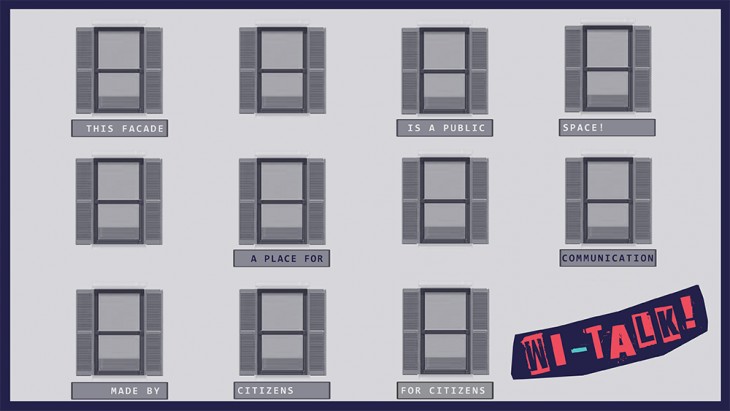
The extended use of technology has changed the way people communicate and use public space. Traditionally public space have been the place of encounter and relation of people, out of their private space in the house. Now seems that technology, connecting people in a global scale, is isolating them in a local scale, breaking the link between the person and the physical space. People mostly use technological gadgets, such as smartphones, for communicate (80% use phone for sending messages, 70% for utilizing social networks).
Are people free to express? Can we transfer the digital world into the physical space? Can we use technology as a tool for connecting citizens in their public space?
The project of Wi-Talk! proposes a device for exploring new models of digital-physical communication at neighborhood scale.
Wi-Talk! is a communication tool that allow people to dialogue with other neighbors through a digital banner hung from their windows. Users can send it text from their phone and the message is visible for people passing by in the public space.
The facade of the building becomes a public space, a place for communication, made by citizens for citizens. This digital banner is a conversation trigger: the discussion can take place in the house, between the people living there about the message to send, and in the street, as a reaction of people that read the message.
Compared to social networks, Wi-Talk! network is open (messages are visible for all people passing by in the public space), is a shared channel (belongs to all the people living behind the window), is a bottom-up platform (a users distributed platform), offers free access (no user profile is required, messages are anonymous) and proposes an unidirectional communication (there in no direct feedback from the readers).
All the messages from the digital banners are collected in an open database and can be used to analyze what is happening in the city or what citizens care about.
There are different possibilities of deployment for the device, according to the different users. It can be used as a public speaker, a protest tool or a local newspaper. This being said, the most interesting use for Wi-Talk! is as communication tool at neighborhood scale. The device connects neighbors by provoking an interest around some common issues.
The technical development of the project can be found here:
https://www.iaacblog.com/programs/wi-talk/
Wi-Talk! is a project of IaaC, Institute for Advanced Architecture of Catalonia developed at Master in City and Technology in 2016 by:
Students: Chiara Dall’Olio
Faculty: Tomás Diez – Mathilde Marengo